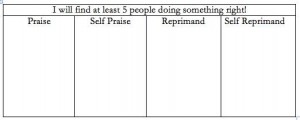Find people doing the right thing.
My articles start with self-evaluation and team reflection. Reflection is the first step to making change. It initiates the awareness that keeps you in tune with your performance. So take a moment and evaluate how you spend your day:
Do you seek out opportunities focusing on errors to correct?
Do you and your team leaders focus on poor performance in order to correct it and eliminate it? Do your employees constantly focus on how not to screw up?
If you answered yes to any of these questions, you most likely feel tired and exhausted, mentally drained or frustrated at the end of your day. Using these steps outlined in this blog will change that.
Auditing performances (team, groups, and individual) with the intent of seeking to correct weaknesses and mistakes is a negative approach to leadership. It does not accomplish a Can Do Will Do environment, instead it creates a fearful environment where people are not invested and will not take risks. While this approach yields results initially, in the long run it will not promote and sustain the positive, self-empowered, team member driven process that result in long-term evolving success. Positive recognition and reinforcement of great performance, paired with coaching and trust however will.
So instead, rewrite the script, change the rules of play, create a new mindset for your team and evolve into an environment that catches people doing things correctly. The following exercise will set the foundation to transform you and your team.
Every game has rules, so first make sure they are clearly defined and the team is given educational and support materials designed to help your team members achieve positive results. (For more tips on how to do this, check out my previous blogs on how to hire the right individuals and how to lead your culture, establish your story, and create open communication).
Try this simple exercise: This exercise is for you and your leadership team to utilize. As a matter of fact, I advise clients not to inform any of the non-management employees about the exercise while you are implementing it.
1. Each manager is to take a 3 x 5 index card and write the following statement across the top. “I will find at least 5 people doing something right today.”
2. Divide the card in to 4 equal quadrants beneath this statement.
3. At the top of each column jot down one the following: Praise, Self Praise, Reprimand, and Self Reprimand. See example below.
4. Here is how it works. It starts with the leadership. Each leader, manager and key employee that is participating will carry this card with him or her every day while they are working. The goal is to catch each other correctly praising team members for good performances. When you see your fellow leader praising a team member, request to see their card. Place a hash mark in the Praise column. If you praise someone and no one is around, give your self a mental pat on the back and put a check in the Self Praise column.
5. If you observe a fellow leader that misses an opportunity to Praise correct performance, you would give them a check in the Reprimand column. If you are by yourself and recognize a missed opportunity to Praise someone, keep track of it and give yourself a Self Reprimand.
Now remember it is important that you do not tell your team employees what you are doing. Doing this practice helps change the leadership mindset and spreads positive feedback to your team. What I enjoying seeing is the peaked curiosity of the team members. Some may even ask what you and your team are doing. Just let them know that you are working on a project.
The reason for the secrecy, it allows you to build credibility through your actions and performance. Your team learns subliminally by observing what you do and how you act. It must align with what you are communicating to them. It must be in sync and consistent. This is where your leadership credibility is derived from. Imagine having a meeting and you tell your team that you are going to change your dynamic and find people doing things right and praise you. The initial reaction will be, “sure we will see how long this last”. Initially this praise will be received and have more impact when they are not expecting it.
One important note with regard to praise, it has to be genuine and specific. Stating to an employee “You did a nice job” is vague and does not reinforce a great performance. A much better way to apply Praise would be “I really appreciate and like the way you handled that project. The details were spot on and captured exactly what we required. Excellent job!”
Play this game and/or exercise for a minimum of 60 days. Start with new cards each day. The result will be very apparent amongst your team. I guarantee their performance will improve and you will feel better about your team, your personal performance and more excited at the end of the day!
When you have success utilizing this information, please write me a comment and let me know how you are doing. If you can’t figure out how to begin this process, or would like to refine your current process, then please contact me now at www.restaurant-innovations.comand let us help!

